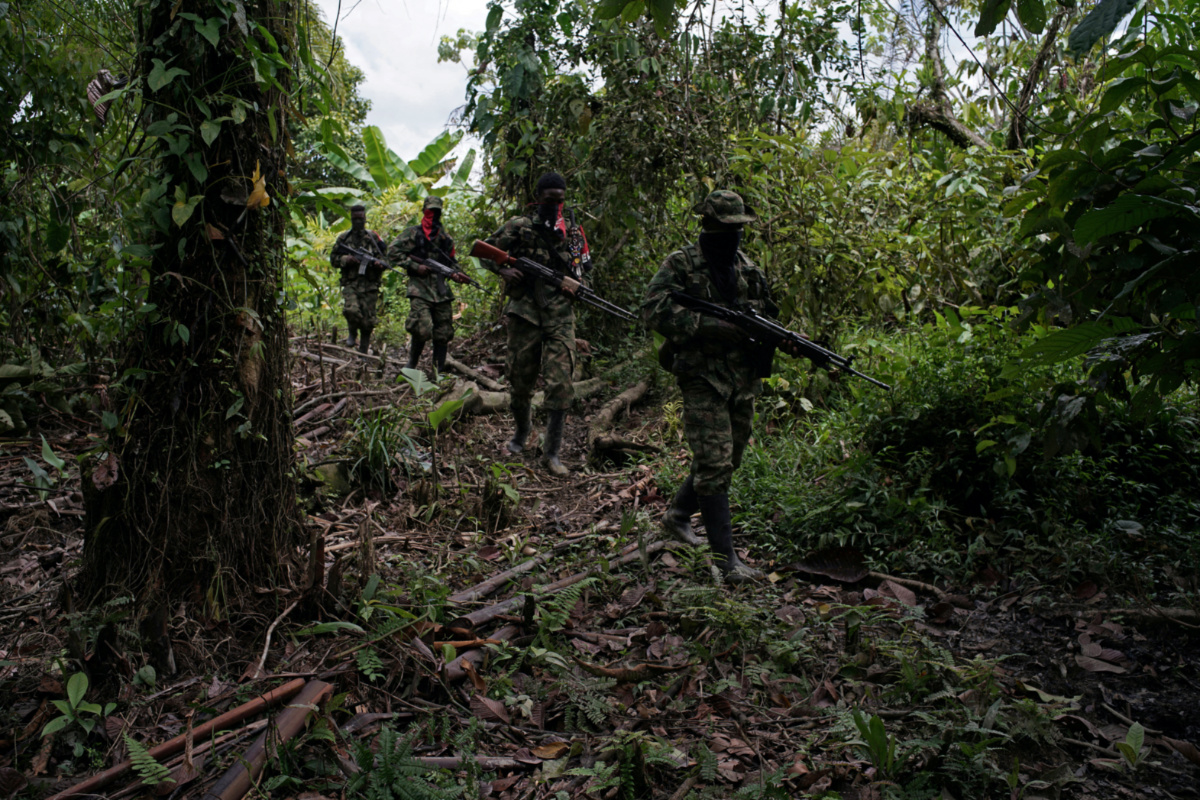Bogota, Colombia
Reuters
More than 17,600 people are members of the four major armed groups and 23 gangs with which the Colombian Government hopes to reach peace or surrender deals, two security agency reports seen by Reuters show.
The newly updated figures, which have not been reported before, are an effort to understand the current composition of the groups, security sources said.

Rebels from Colombia’s Marxist National Liberation Army (ELN) patrol an area, in the north-western jungles, Colombia, on 31st August, 2017. PICTURE: Reuters/Federico Rios/File photo
The new figures are higher than that of previous official estimates, but are also a fundamental check on the groups’ own membership claims, which are often inflated, said the sources.
They said the reports, which were compiled by the armed forces, will be shared with President Gustavo Petro and his defence minister at a coming security meeting.
Petro has promised to end Colombia’s six-decade conflict, which has killed at least 450,000, through peace deals or surrender agreements, which would see criminal groups receive reduced jail sentences in exchange for information and disarmament.
Senator and security expert Ariel Avila, who has seen preliminary figures from the reports, told Reuters that it was important to ensure that those who received the benefits of such deals were truly members of armed groups.
“Intelligence reports serve for the art of war, but on issues of peace they serve to avoid gatecrashers,” he said.
According to the reports, many of those counted as armed group or gang members do not usually carry weapons themselves, but are part of support networks that provide combatants with supplies, ferry communications, share intelligence, or even plant bombs.
The leftist National Liberation Army (ELN) rebels – already in peace negotiations with the government – are the largest of the armed groups.
Of the ELN’s 5,850 members, 2,900 are combatants, while 2,950 are part of its support network, showed one report, marked as “secret” and compiled using information gathered through 31st March.
A third round of talks between the ELN and the government is set to begin shortly in Cuba, with conversations expected to focus on a potential bilateral ceasefire.
The next largest group, according to the reports, is the Clan del Golfo – founded by former right-wing paramilitaries and also known as the Gaitanista Self-Defense Forces – with 4,060 members, 1,620 of whom are combatants.
“[Clan] structures are concentrated on control of drug trafficking routes and exits to Europe, the United States and Central America,” said one of the reports, adding that the group has expansion plans and is seeking to control drug and arms routes on the border with Venezuela.
We rely on our readers to fund Sight's work - become a financial supporter today!
For more information, head to our Subscriber's page.
The government last month suspended a ceasefire with the Clan, accusing it of inciting violence at demonstrations by wildcat miners, though it has said the door to dialogue remains open.
Dissident groups founded by former members of the FARC rebels who reject a 2016 peace deal are also included in the count.
The Estado Mayor Central, which never participated in the FARC negotiations, has some 3,530 members, including 2,180 combatants.
The attorney general has already suspended arrest warrants for some members of that group, a concrete step toward negotiations.
Another major FARC dissident group, Segunda Marquetalia, has 1,670 members. Most – 1,060 – are combatants.
The government also wants to hold talks with Segunda Marquetalia, though it is unclear if they are eligible for a peace or surrender deal.
The dissidents fight the ELN and the Clan for territorial control, especially in cocaine-producing areas, one of the reports said.
Apart from the larger and more powerful armed groups, 23 urban gangs – the majority in cities like Medellin, Buenaventura and Quibdo – have a total of 2,500 members, according to one of the reports.
The gangs, which the report says are involved in drug trafficking, would be subject to surrender deals under Petro’s plan.
Just two groups in Buenaventura, a Pacific port city with drug trafficking routes, have a combined 830 members.






